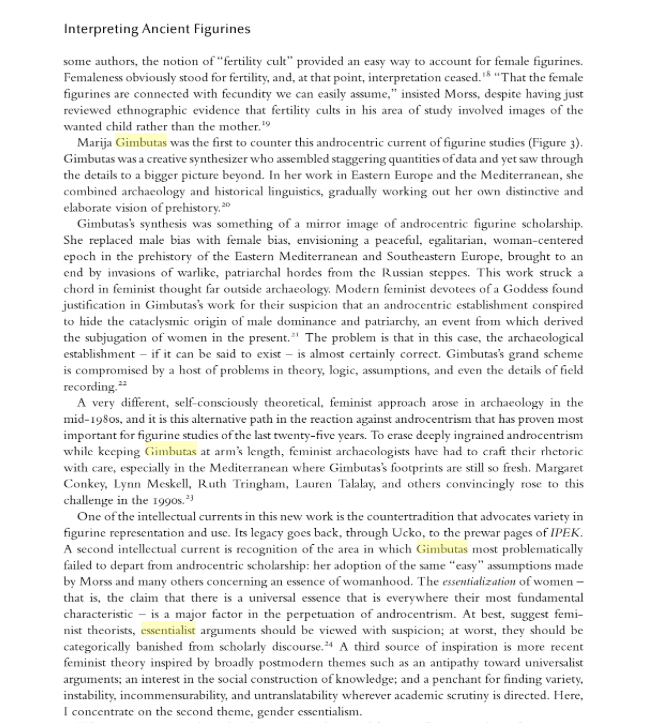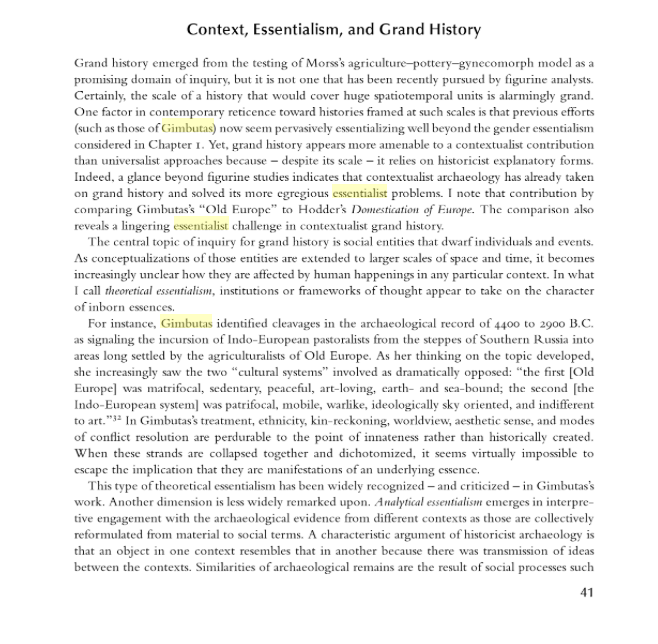T H E T O T A L L Y U N W A R R A N T E D A C C U S A T I O N
O F M A R I J A G I M B U T A S B E I N G A N " E S S E N T I A L I S T"
Quoting Charlene Spretnak in her article:

In a similar vein, ( as the accusations of being "oudated" a. s. o. by Meskell, Conkey & Tringham et. al.: See former page ») the accusation of “essentialist” was repeatedly affixed to Gimbutas’ work in the 1990s. It began with Conkey and Tringham who claim that Gimbutas’ reading of prehistory is so “essentialized” that it precludes “an engendered prehistory” that “envisages women as thinking and acting people who affect the course of prehistory.”90 The charge was repeated by many other feminist archaeologists and was also applied to the “Goddess movement,” which Gimbutas’ detractors delight in erroneously conflating with her. For instance, Lucy Goodison and Christine Morris (formerly a research assistant for Renfrew) state in their introduction to the anthology Ancient Goddesses,
`Their biologically essentialist vision is one which they share with reactionary forces who have always opposed the emancipation of women; it serves, as Lauren Talalay has pointed out: “to isolate women outside of history. ... If women’s reproductive capabilities are the source of their power, then women remain, to some extent, locked within an unchanging domestic sphere.91´
Essentialist is a derogatory term that was invented in post-structuralist feminist circles in the 1980s to demean any women who noted, say, a connection between female embodiment and religious honoring in any past or present culture; it was claimed that any such honoring necessarily limits women to nothing but our biology and prevents us from being agents of culture. The “anti-essentialist” scholars accept the traditional divide in patriarchal societies between nature and culture, agreeing that any association with nature situates one on the wrong side of the chasm. Although I have been addressing this straw-man argument since 1991 (in States of Grace), suffice it to say here that it is nonsensical that anyone could read the passages cited above from Gimbutas’ writings about women and culture in Old Europe and honestly accuse her of viewing women as not being cultural agents and being outside of history.
Finally, Gimbutas’ conclusions about Old Europe as a matristic but balanced (roughly egalitarian) civilization was apparently enough to set off alarm bells in the psyche of many male archaeologists and journalists, who reacted with angry charges such as “A Sexist View of Prehistory” (Brian Fagan) and “Gyno- supremacism” (a journalist writing in the Chicago Tribune).92 Visceral feelings about the utter rightness of patriarchal culture and a male godhead are apparently no more uncommon in archaeology than elsewhere.93 Even Gimbutas’ observation that most of the Neolithic figurines were female is seemingly received by some male archaeologists as an affront that requires retribution.
90 Conkey and Tringham 1994: 219.
91 Goodison and Morris 1998: 14.
92 Margolis 1995.
93 See Goldenburg 1997.
Interpreting Ancient Figurines: Context, Comparison, and Prehistoric Art
By Richard G. Lesure
As Richard Leisure also is embracing the derogatory idea about Gimbutas´ alleged "essentialism" I wrote an e- mail and asked him to specify the reason to why he labelled her as such, and then he send a mail back in which he simply referred to Cynthia Ellers: The Myth of Prehistory;Why An Invented Past Will Not Give Women a Future .


More to read about the subject »